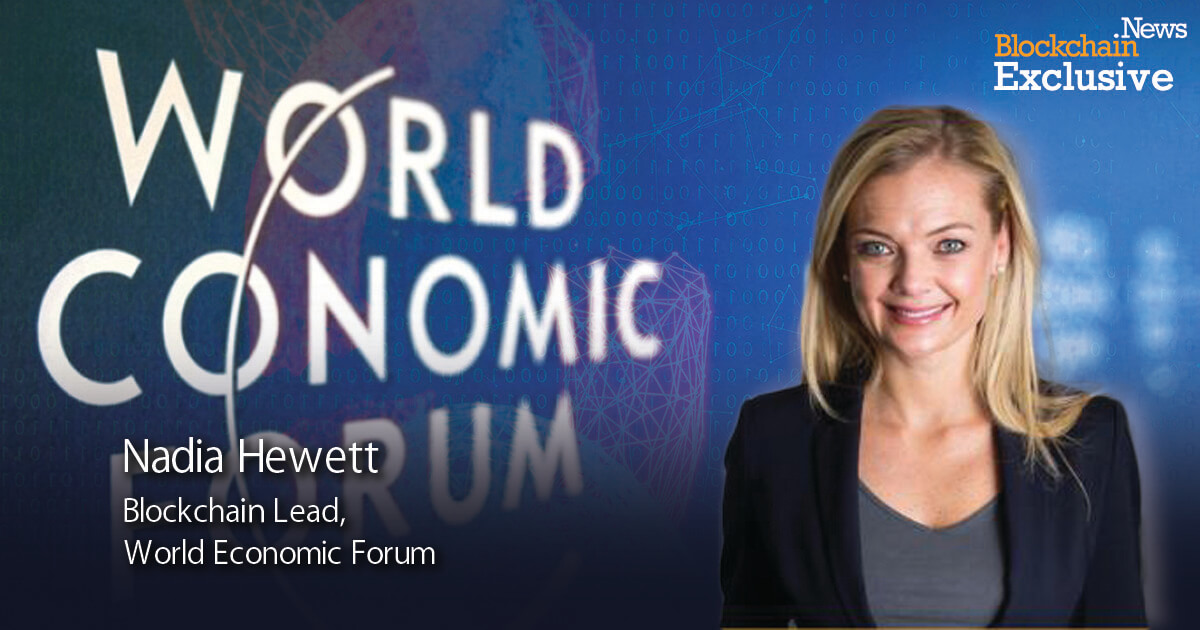World Economic Forum Blockchain Lead Explains: To What Extent Can Blockchain Solve Supply Chain Issues?
The World Economic Forum (WEF) recently published a new blockchain deployment toolkit aimed to help governments, major institutions, and companies of any size to be able to maximize the benefits of integrating blockchain technology in the supply chain sector. The Forum also highlighted the importance of blockchain for addressing the disruption of supply chain caused by the COVID-19 pandemic.

Blockchain.News exclusively interviewed the World Economic Forum’s blockchain project lead, Nadia Hewett, to get to know more about the Forum’s current blockchain development in the supply chain, and the organization’s future roadmap.
Removing the hype in blockchain
Hewett explained that supply chain gained the most traction from the Forum as an area to develop, as the technology had the most exploration due to the fact that the government and private sector partners have shared a number of issues they have had with blockchain in supply chains.
One of the most common issues was that these partners found it difficult to distinguish the “real deal from the marketing message.” As there was a lot of hype in the industry, a lot more education could be provided to these companies as the information they should receive should remain impartial.
Another issue that the Forum identified, was that a lot of the proof of concept explorations was only happening between one or two parties, which meant it did not involve multi-stakeholders.
Blockchain benefits for supply chain: Transparency and resiliency
In order to encourage responsible deployment, Hewett said, “The toolkit was seen as a way that we can shape the deployment with integrity to be more responsible, inclusive, and interoperable. This is one of the main reasons that we started this toolkit and landed the framework to shape the global supply chain.” Hewett previously worked in supply chain at Maersk, before starting her position at the Forum.
The 14 modules in the World Economic Forum report covered the most important topics considered by the Forum for well-thought-out blockchain deployment. Categorized by three main pillars, including comply, connect, and create, these modules provide a complete guideline when developing a blockchain solution for supply chain purposes.

“When you embark on developing a blockchain solution, there are a number of things you need to do to comply, therefore these modules are necessary for compliance. This includes legal and regulatory compliance risk factors, tax implications, financial reporting, and control,” said Hewett.
She further explained that the Forum accelerated the release of the toolkit, in light of the coronavirus pandemic. With the benefits of blockchain technology, she said, “We have a toolkit so that it would be available as responses to future long term global pandemic preparedness are undertaken. We believe that the blockchain deployment toolkit has a number of features that have a lot of potential to help with supply chain transparency, supply chain resiliency.”
In the short term, there have been a few blockchain solutions being used to address issues caused by COVID-19, but Hewett believes that blockchain has the potential to improve supply chain resiliency. With the onset of faulty medical gear such as counterfeit personal protection equipment, it further highlights the challenges blockchain could mitigate for the future, including the added transparency and resiliency to the sector, and with trusted data. She stated:
“A lot of organizations who also have to work with new suppliers in short notice during the pandemic also need to verify the trustworthiness of these suppliers. Blockchain has an opportunity there for trustworthy verification suppliers to happen on a distributed basis. This way, companies can share with each other some of the prominent information they already have."
The toolkit was tested by businesses for a period of time, to make sure it is user-friendly and can have an impact on companies in the future. She added, “Not only are we now providing the toolkit and all the lessons in subsequent COVID blockchain activities to our partners, governments and private sector; while we developed the toolkit and other ongoing projects, we brought in partners to help co-create and design it with a user-centric approach in mind.”
Taking data interoperability in mind, the toolkit breaks the issue down into three main layers, including governance. At this layer, business models and interoperability, legal and compliance interoperability, is also taken into account, rather than just blockchain to blockchain interoperability. “These are very important layers that are also necessary for ecosystems and blockchain consortia to look and pay attention to.”
Blockchain for post-COVID economic recovery
The World Economic Forum believes with the accelerated release of the blockchain deployment toolkit will also help with the economic recovery post-pandemic. Hewett says that many countries will rely on digitization for its economic recovery, as digitization for trade could act as a way to reduce trade barriers, given all the geopolitical issues.

“The blockchain deployment toolkit is available as all these organizations embark on taking the opportunity to boost the systems to better serve the supply chains we need for the future,” said Hewett.
Since the emergence of the COVID-19 pandemic, the Forum launched the COVID Action Platform, to work with governments, public and private organizations around the world for COVID-preparedness and digitization.
“We convene the public and private sector so we can provide them with a safe space to be able to share with each other the best practices and to have dialogues to allow them to progress and economic reform and other important initiatives that the world needs to tackle,” she added.
The public vs. private debate
Hewett urges enterprises to not get too caught up in the public vs. private blockchain debate. She believes that despite the media attention, organizations should focus on designing a solution that meets its key requirements.
Large organizations usually require typical requirements such as regulatory compliance, and information-sharing agreements. “At the end of the day, in meeting enterprise requirements, there likely will be permissioned blockchain in some form or another, because if you look at public permissionless systems such as Bitcoin, it doesn’t meet a lot of enterprise requirements as there are no known and trusted partners,” said Hewett.
With international trade, there are certain requirements to consider which makes it lean more towards a private permissioned type system being set. With public systems, it is also possible to add certain degrees of permissions on it, although it is necessary to note that every permission added is a centralized component, which takes away some of the decentralization benefits.
“In the toolkit, we also warn those who design blockchain solutions, that the more centralized components added to the decentralized components, the more diluted the decentralized features will be, taking away some of the features blockchain has to offer,” said Hewett. This questions whether there is a need for blockchain to be integrated into the solution, as it is very centralized.
Understanding the issues in supply chain: Data siloes
One of the key issues in supply chains is the lack of transparency. Looking deeper into this issue reveals that the key stakeholders in the supply chain have a lack of willingness to share data, artificially creating “data siloes” for the benefit of staying in power. “It’s a way for them for incumbents to keep their value proposition,” she added.
“The lack of data sharing is a large problem. Companies want to artificially keep their data centers private because it gives them a competitive advantage. The lack of data sharing also has to do with compliance and security issues, including cybersecurity."
The phenomenon of data sharing is also not educated, Hewett believes that the governance aspect remains the most difficult issue. Blockchain, with its near zero-knowledge-proof feature and with the toolkit could significantly help with data sharing, data confidentiality, and personal data handling.
Governance of emerging technologies
The Fourth Industrial Revolution was established years ago to help with the governance of these emerging technologies, including blockchain, internet of things (IoT), and artificial intelligence (AI). Government regulation has not kept up with these emerging technologies. “We want to make sure that these technologies are inclusive, where everybody around the world can benefit from it. We are working on different ways to govern these technologies, to make sure it is used responsibly.”

By putting forward the toolkit, the Forum is sharing the best practices for using blockchain in the supply chain sector, as government regulation some time to keep up with the technologies. “We also share what the costly mistakes are, where we can learn from everybody, what failures they have encountered, what they are usually not sharing with the world. We did the hard work and put it together in a toolkit so that companies can use it as a resource to help them to be more responsible in deploying the blockchain solution,” explained Hewett.
New blockchain initiatives to be expected
Hewett mentioned that there are always ongoing new blockchain projects being added, as the Forum remains impartial to help industries come together to build blockchain consortia.
“The World Economic Forum provides that sort of neutral place where we can help companies to reach fair governance and so on, with the industries that we assist with."
One of the initiatives that the Forum has been a part of was the Mining and Metals blockchain initiative, which initially did not have any data standardization nor interoperability. The Forum acted as the “glue” that brought companies together to help them reach fair governance. The organization is also working on a large project with central banks around the world.
In early 2020, the World Economic Forum launched The Global Consortium for Digital Currency Governance. She concluded, “There’s a lot happening within digital currencies. With this global consortium, the Forum aims to design a framework for the governance of digital currencies, including stablecoins. Going forward, we will also launch projects and activities around data for common purposes, such as how to share data.

